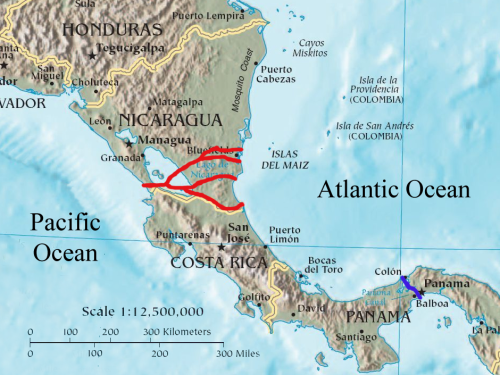
This article was originally published by Offiziere.ch on 5 December, 2014.
A Chinese company is preparing to begin work on the Nicaragua Interoceanic Canal. Once — and if — the canal is ever finished, it will size up to more than 170 miles (about 275 km) and connect the Caribbean Sea to the Pacific Ocean, with Lake Nicaragua in the middle. It’s a major project — larger than any other geo-engineering project underway in the world. Officially, it’s an opportunity for development championed by Nicaraguan President Daniel Ortega. But critics look at the canal as a boondoggle, and a means by which Ortega is developing a long-term relationship with Beijing — and China’s geopolitical interests. The builders of the canal also have important ties with the Chinese People’s Liberation Army (PLA).
In June 2013, Nicaragua granted canal construction rights to the Hong Kong Nicaragua Canal Development Company (HKND), a conglomerate of firms established a year before and headed by Chinese billionaire Wang Jing. Wang is an obscure entrepreneur and it’s unclear how exactly he made his fortune, although much of it appears to have come from telecommunications. The canal project is risky for a little-known developer, especially considering the $50 billion cost, but also potentially very lucrative for Wang. But what’s also worth noting is that Wang has extensive ties with the Chinese military. That’s just one part of a recent investigation on the canal project by Nicaraguan weekly newspaper Confidencial.
HKND is not a single company, but a group of at least 15 different companies. These include Skyrizon Aircraft Holdings, registered in the British Virgin Islands and includes seven Dassault Falcon business jets. HKND includes the Southeast Asia Agriculture Development Group, which invests in mining and agriculture in Cambodia. HKND includes companies for investing in “sports and culture” and the arts. There’s also the telecom company Beijing Xinwei, of which Wang is chairman. This last company is associated with the Chinese military. Beijing Xinwei openly advertises its industrial-scale telecommunications projects, such as cellular towers and broadband communication standards. “Its goal has been more involved in industrial private networks, and so-called ‘special communications,’” reported Confidencial. “That is, government projects linked to the army, rather than the large local market of individual private telecommunications.”
According to the report, which cited a Guotai Jun’an Securities investment report, Xinwei is working on the People’s Liberation Army’s “brains of the future military network.” The newsweekly also refers to “special communications” as a Chinese industrial term for hardware “related to national interests, such as the military and public safety.” The nature of Xinwei’s involvement in Chinese military networks is unclear. Beijing is heavily focused on improving its strategic and operational-level communications, and has been for decades.
“The command automation data network can support domestic operations and conventional attack options along China’s borders,” Christopher Sterling and Cliff Lord noted in Military Communications: From Ancient Times to the 21st Century. “China still lags behind Western standards for controlling complex joint operations and lacks the robust architecture required to meet the demands of the modern battlefield.”
Part of Xinwei’s work with the PLA is in satellites. The company is working on a “wireless broadband platform” for the BeiDou system of navigation satellites — an alternative to the Global Positioning System and the Russian GLONASS. Xinwei is also working on a constellation of communications satellites. These could have military dual uses. And Xinwei has licenses to deal directly with the PLA, according to Confidencial.
But what does any of this have to do with the Nicaraguan canal? It has to do with who the beneficiaries of the project will be. As Nina Lakhani detailed in The Daily Beast, the project has blown up into a “mix of fury, fear and defiance not witnessed since the Contra War ended in 1988,” Lakhani wrote.
Nicaraguan activists are upset for several reasons. Not only because of inevitable land evictions to make way for the canal, but there’s the risk of environmental destruction — and allegations of Nicaraguan soldiers intimidating residents along the planned canal route.
“It’s less a concern about the Chinese military than it is an issue of transparency,” blogged James Bosworth, an analyst at Latin America advisory firm Southern Pulse. “If Nicaragua President Ortega has sold off the rights to the Canal to the Chinese government and military as a geopolitical project rather than a profitable development project for the country, then the Nicaraguan people have a right to know.”
There’s reasons to think the project is more the former than the latter. Not that there are no commercial interests for the canal project. But the fact that Beijing is leading the project and is the largest investor means it’s not simply about making money. A Nicaraguan canal would give China and alternative route if relations deteriorated to the point of an American blockade of Chinese shipping through Panama. A Nicaraguan canal could also be built to accommodate super-heavy containers used to ship agricultural products from Brazil to China, and Chinese goods in the opposite direction.
It’s worth noting the Panama Canal wasn’t simply about business when the United States constructed the corridor in the early 20th century. It was the means by which the U.S. would connect its coastlines and exercise naval supremacy over the Western Hemisphere. China’s canal in Nicaragua won’t amount to anything close to that. But it’s an insurance policy, and a foot into Central America.
Robert Beckhusen is a freelance writer and contributor to Offiziere.ch and War is Boring.
For more information on issues and events that shape our world, please visit ISN Security Watch or browse our resources.

